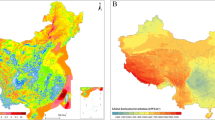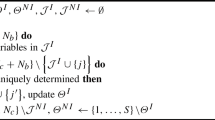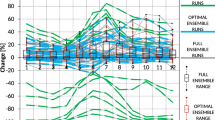Abstract
Quantifying the complementary characteristics of the wind-photovoltaic-hydro(W-PV-H) system under multiple uncertainties is very important for the planning and operation of W-PV-H system. Due to the randomness of hydrometeorological elements, W-PV-H system has multiple uncertainties which is difficult to describe. Besides, the complementarity of W-PV-H system with three energy sources cannot be directly clarified by the available indicators, which brings challenges to the development of W-PV-H system. To reveal the complementary mechanism of W-PV-H system under multiple uncertainties, the Asymmetric Archimedean Copula (AAC) based on the fully nested method and the maximum possible weight function are combined to characterize the multiple uncertainties of W-PV-H system. Then the comprehensive complementarity coefficient(CCC) is established by coupling spatial coordinates and compromise planningto quantify the complementary characteristics of W-PV-H system. The method proposed in this paper is applied to the upper reaches of the Yellow River. The results show that AAC has advantages in constructing joint probability distributions compared with Symmetric Archimedean Copula. The most probable solutions under multiple return periods are all located near the cumulative frequency contour. Under various joint probabilities, the CCCs in the study area are all greater than 0.5, which indicates that the W-PV-H system has certain complementarity in medium-long-term. The medium-long-term complementarity in wind-hydro and PV-hydro are better, and the complementarity in wind-PV is the worst. Morever, the medium-long-term compensation relationship in W-PV-H system is revealed through two models with the participation of wind and PV power or not.












Similar content being viewed by others
Data Availability
The authors confirm that all data supporting the findings of this study are available from the corresponding author by reasonable request.
Code Availability
The code that supports the findings of this study is available from the corresponding author upon reasonable request.
References
Avila L, Mine MRM, Kaviski E et al (2021) Evaluation of hydro-wind complementarity in the medium-term planning of electrical power systems by joint simulation of periodic stream flow and wind speed time series: a Brazilian case study. Renew Energy 167:685–699
Bai KF, Gu J, Peng HQ et al (2018) Optimal alloction for multi-energy complementary microgrid based on scenario generation of wind power and photovoltaic output. Autom Electr Power Syst 42:133–141
Bertsekas DP, Tsitsiklis JN (2008) Introduction to probability 2E. Athena Scientific, Belmont
Bertsiou MM, Baltas E (2022) Energy, economic and environmental analysis of a hybrid power plant for electrification, and drinking and irrigation water supply. Environ Process 9:22
Canales FA, Jurasz J, Beluco A et al (2020) Assessing temporal complementarity between three variable energy sources through correlation and compromise programming. Energy 192:116637
Cantão MP, Bessa MR, Bettega R et al (2017) Evaluation of hydro-wind complementarity in the Brazilian territory by means of correlation maps. Renew Energy 101:1215–1225
Cao H, Qiu J, Zuo HM et al (2023) A long-term operational scheme for hybrid hydro-photovoltaic (PV) systems that considers the uncertainties in reservoir inflow and solar radiation based on scenario trees. Water Resour Manag 37:5379–5398
Chen ZS, Li HH (2020) Design rainstorm hydrograph in Zhuhai city based on asymmetrical GH-copula. Acta Scientiarum Naturalium Universitatis Sunyatseni 59:95–101
Chen ZS, Huang Q, Liu ZM (2016) Risk assessment of trivariate flood based on asymmetric Archimedean Copulas. Adv Water Sci 27:763–771
de Jong P, Sanchez AS, Esquerre K et al (2013) Solar and wind energy production in relation to the electricity load curve and hydroelectricity in the northeast region of Brazil. Renew Sust Energ Rev 23:526–535
dos Anjos PS, da Silva ASA, Stosic B et al (2015) Long-term correlations and cross-correlations in wind speed and solar radiation temporal series from Fernando De Noronha Island, Brazil. Phys a 424:90–96
Gburčik P, Gburčik V, Gavrilov M et al (2006) Complementary regimes of solar and wind energy in Serbia. Geogr Pannonica 10:22–25
Gershon M, Duckstein L (1983) Multiobjective approaches to river basin planning. J Water Resour Plan Manage -ASCE 109:13–28
Hatamkhani A, Shourian M, Moridi A (2021) Optimal design and operation of a hydropower reservoir plant using a WEAP-based simulation–optimization approach. Water Resour Manag 35:1637–1652
Huang TZ, Cheng CY (2003) Linear algebra and spatial analytic geometry. Higher Education Press, Beijing
Huang C, Karimi HR, Mei P et al (2023) Evolving long short-term memory neural network for wind speed forecasting. Inf Sci 632:390–410
Li Y (2022) Long-term optimal operation of hydro-wind-solar hybrid energy system nested with short-term operating risk. Dissertation, Institute of Water Resources and Hydroelectric Engineering, Xi’an University of Technology
Liang ZM, Zhong PA, Hua JP (2006) Hydrological and hydraulic calculation. China Water and Power Press, Beijing
Liu Z (2021) Photovoltaic capacity optimization of hydro-photovoltaic hybrid energy systems based on joint optimization operation. Dissertation, School of Water Conservancy Engineering, Zhengzhou University
Liu Y, Xiao L, Wang H et al (2013) Analysis on the hourly spatiotemporal complementarities between China’s solar and wind energy resources spreading in a wide area. Sci China-Technol Sci 56:683–692
Meng JY, Dong ZC, Shao YQ et al (2023) Monthly runoff forecasting based on interval sliding window and ensemble learning. Sustainability 15:100
Miglietta MM, Huld T, Monforti-Ferrario F (2017) Local complementarity of wind and solar energy resources over Europe: an assessment study from a meteorological perspective. J Appl Meteorol Climatol 56:217–234
Ren Y, Yao XH, Liu D et al (2022) Optimal design of hydro-wind-PV multi-energy complementary systems considering smooth power output. Sustain Energy Technol Assess 50:101832
Salvadori G, De Michele C, Durante F (2011) On the return period and design in a multivariate framework. Hydrol Earth Syst Sci 15:3293–3305
Santos-Alamillos FJ, Pozo-Vazquez D, Ruiz-Arias JA et al (2015) Combining wind farms with concentrating solar plants to provide stable renewable power. Renew Energy 76:539–550
Silva AR, Pimenta FM, Assireu AT et al (2016) Complementarity of Brazil’s hydro and offshore wind power. Renew Sust Energ Rev 56:413–427
Song SB, Cai HJ, Jin JL et al (2012) Copula function and its application in hydrology. Science Press, Beijing
Song H, Al Khafaf N, Kamoona A et al (2023) Multitasking recurrent neural network for photovoltaic power generation prediction. Energy Rep 9:369–376
Srdevic Z, Srdevic B, Suvocarev K et al (2020) Hybrid constructed wetland selection as a group decision-making problem. Water Resour Manag 34:295–310
Volpi E, Fiori A (2014) Hydraulic structures subject to bivariate hydrological loads: return period, design, and risk assessment. Water Resour Res 50:885–897
Wang ZN, Wen X, Tan QF et al (2021) Potential assessment of large-scale hydro-photovoltaic-wind hybrid systems on a global scale. Renew Sust Energ Rev 146:111154
Widen J (2011) Correlations between large-scale solar and wind power in a future scenario for Sweden. IEEE Trans Sustain Energy 2:177–184
Xu LJ, Wang ZW, Liu YF (2017) The spatial and temporal variation features of wind-sun complementarity in China. Energy Conv Manag 154:138–148
Yuan WL (2017) Calculation of hydrology and water conservancy. China Water & Power Press, Beijing
Zhao MZ, Wang YM, Wang XB et al (2022) Flexibility evaluation of wind-PV-hydro multi-energy complementary base considering the compensation ability of cascade hydropower stations. Appl Energy 315:119024
Zhu FL, Zhong PA, Xu B et al (2020) Short-term stochastic optimization of a hydro-wind-photovoltaic hybrid system under multiple uncertainties. Energy Conv Manag 214:112902
Zhu FL, Fan YK, Liu WF et al (2023) Research on the complementary characteristics of the hydro-wind-solar power output in the Longyangxia area. China Rural Water and Hydropower 3:181–185
Funding
The work described in this paper was supported by the Scientific Research Projects of Henan Province (No.202102310296), the National Natural Science Foundation of China (No. 52109041) and China Postdoctoral Science Foundation (No. 2021M690139).
Author information
Authors and Affiliations
Contributions
All authors contributed to the study conception and design. Methodology, Writing-Review & Editing were performed by Lu Lu. Software, Writing-Original Draft, Validation, Funding acquisition were performed by Wenlin Yuan. Conceptualization, Supervision, Project administration, Writing-Review &Editing were performed by Hongshi Xu. Investigation was performed by Chengguo Su. Data Curation was performed by Denghua Yan. Formal analysis was performed by Zening Wu.
Corresponding author
Ethics declarations
Ethical Approval
We certify that the submission is original work and is not published at any other publications.
Consent to Participate
All authors gave explicit consent to participate in this work.
Consent to Publish
All authors gave explicit consent to publish this manuscript.
Conflict of Interest
The authors declare that they have no known competing financial interests.
Additional information
Publisher’s Note
Springer Nature remains neutral with regard to jurisdictional claims in published maps and institutional affiliations.
Electronic Supplementary Material
Below is the link to the electronic supplementary material.
Rights and permissions
Springer Nature or its licensor (e.g. a society or other partner) holds exclusive rights to this article under a publishing agreement with the author(s) or other rightsholder(s); author self-archiving of the accepted manuscript version of this article is solely governed by the terms of such publishing agreement and applicable law.
About this article
Cite this article
Lu, L., Yuan, W., Xu, H. et al. Evaluation of the Complementary Characteristics for Wind-Photovoltaic-Hydro Hybrid System Considering Multiple Uncertainties in the Medium and Long Term. Water Resour Manage 38, 793–814 (2024). https://doi.org/10.1007/s11269-023-03699-3
Received:
Accepted:
Published:
Issue Date:
DOI: https://doi.org/10.1007/s11269-023-03699-3




